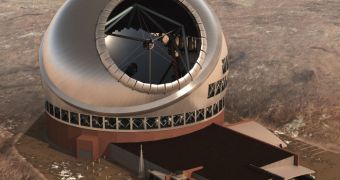Officials at the University of Hawaii announce that they received late last week the necessary permit to construct a $1.3 billion space observatory on the summit of Mauna Kea, on Hawaii's Big Island.
The volcano has been dormant for many years, and so the Department of Land and Natural Resources (DLNR), operated by the Hawaiian government, finally agreed to let the astronomers go on with their plans for the Thirty Meter Telescope (TMT).
The facility, which will be one of the most powerful of its type in the entire world, will therefore be constructed at an altitude of 13,803 feet (4,207 meters) above sea level. The permit was issued on Friday, February 25.
According to officials with the TMT project, this permit is the final stage in a multi-year approval process. The endeavor took into account the potential cultural and environmental impacts.
“The Thirty Meter Telescope has worked diligently during the past three years to design an observatory that would minimize its environmental and cultural impact,” explains Sandra Dawson.
“The TMT project also fulfills the requirements outlined in the recently approved Comprehensive Management Plan for Mauna Kea,” she adds. Dawson is the manager of Hawaii Community Affairs for the TMT project.
One of the reasons why this facility is so important for science is that it will conduct observations of the night sky in a variety of wavelengths, ranging from mid-infrared (IR) to ultraviolet (UV).
It will feature a 30-meter (98-foot) primary mirror, that will enable the TMT to reach nine times the light-collecting power of existing telescopes operating in optical and IR wavelengths today.
The TMT mirror will be three times as large as the Keck Telescope's 10-meter main instrument. The Keck is used as the primary means of investigating the validity of discoveries made by the NASA Kepler planet-hunting telescope in Earth's orbit.
According to specifications, the TMT will also feature an advanced adaptive optics (AO) system, that will allow it to compensate for the image flicker produced when light passes through the atmosphere.
It is estimated that the Thirty Meter Telescope will be able to take images more than 12 times sharper than those snapped with the NASA Hubble Space Telescope, one of the four Great Observatories.
Construction atop Mauna Kea could begin as early as 2012. TMT officials hope that the new telescope will be able to start conducting studies by 2020, Space reports.
Some of the partners in the project include the California Institute of Technology, the University of California, the Association of Canadian Universities for Research in Astronomy, the National Astronomical Observatory of Japan and the Department of Science and Technology of India.

 14 DAY TRIAL //
14 DAY TRIAL //